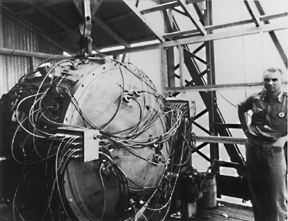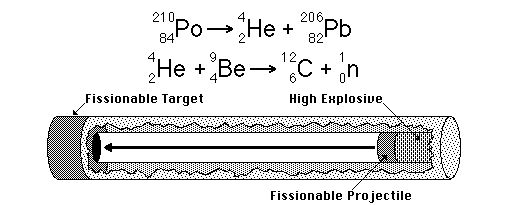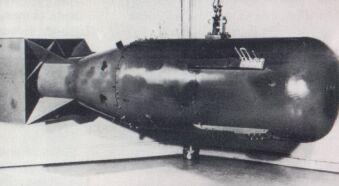Time Travel Research Center © 2005 Cetin BAL - GSM:+90 05366063183 - Turkey / Denizli
The Atomic Bomb
 |
 |
|
Trinity Test
Ground Zero
3,400 yards northwest of
McDonald Ranch Kenneth T. Bainbridge marked out ground zero. From the center at
compass points roughly north, west and south at 10000-yard distances the Corps
of Engineers built earth-sheltered bunkers with concrete slab roofs supported by
oak beams thicker than railroad ties.
N-10000 recording instruments and
searchlights 5.7 miles from ground zero
W-10000 searchlights and high-speed
cameras
S-10000 command center
5 miles south of S-10000 was a base camp
with tents and barracks
A hill named Compañia 20 miles northwest of ground
zero was a VIP senic overlook.
Towers
800 yards from zero bolted together 20 ft high in trestles of heavy
wooden beams topped by a wide platform. at the top. 100 tons of high-explosive
in wooden boxes on May 7, 1945
100 ft tall tower at zero. four legs spaced 35 feet apart braced with crossed struts sheltered on three sides with sheets of corrugated iron.
Countdown
0525 green Very rocket goes up; siren at Base camp gives a short
wail.
0527 green Very rocket goes up; siren at Base camp gives a long
wail.
0529 green Very rocket goes up
0529 automatic timer
engaged
0529:15 X-unit fully charged
0529:35 gong sounds in control bunker
(S-10000)
0529:45 detonation of atomic bomb
Yield: 18.6 KT
Production of Enriched Uranium
Oak Ridge
gaseous
diffusion
thermal-diffusion
centrifuge seperation
Production of Plutonium
Hanford, Washington
Delivery of the Atomic Bombs
Little Boy
Fat Man
July 26 USS Indianapolis arrives at Tinian, delivers the Little
Boy gun and bullet.
Air Transport Command (ATC)
Three C-54s left Kirtland
AFB with the three separate pieces of the Little Boy's target assembly, two more
C-54s departed with the Fat Man's initiator and plutonium core.
August 2
three B-29s arrive at Tinian from Kirtland Air Force Base, New Mexico each
carrying a Fat Man high-explosive preassembly.
Composition B (TNT + RDX)
Baratol (Barium nitrate + aluminum powder + TNT
+ straroxyacetic acid + nitrocellulose)
Manhattan Project

Introduction
On 2 August 1939 some scientists wrote to President Roosevelt of efforts in Nazi Germany to purify Uranium-235 with which might in turn be used to build an atomic bomb. It was shortly thereafter that the United States Government began the serious undertaking known only then as the Manhattan Project. The Manhattan Project was designed to research and production that would produce a usable atomic bomb. The Project was named after the Manhattan Engineer District of the US Army Corps of Engineers, because a lot of the early research was done in New York.
In 1942 General Leslie Grove was chosen to oversee the project while the brilliant young physicist Robert Oppenheimer was appointed to lead the scientific team.
Initial Research
This came in the latter part of 1942 with work done at Chicago University led by Enrico Fermi. He developed and brought to life the world's first atomic reactor (atomic pile.) In affect this was a slow motion atomic bomb proving that the concept and scientific principles were sound. The atomic reactor undergoes nuclear fission (the same process that powers an atomic bomb) but, of course, under controlled conditions.
Atomic Bomb
Remember back when all we had to worry about was The Bomb? Not a dirty bomb, or a crop duster, or a hijacked jet-missile, or anthrax in the mail, or smallpox-ridden subway riders, or sarin gas suitcases, or fertilizer-packed trucks. There was just "The Bomb."
Science had known about the atom since the days of ancient Greece, but the idea wasn't fully understood until the beginning of the 20th Century. After thousands of years of gestation, the idea for an atomic bomb the catastrophic release of energy produced by a chain reaction of atoms splitting came in 1933, when a physicist in Hungary named Leo Szilard figured it out. He even patented the idea.
It might have taken millennia to come up with the notion of the atomic bomb, but it took just 12 years from the first public articulation of the idea to The Bomb's first public use to kill enemies in a war.
After the atom was first split for energy in 1938, Albert Einstein wrote a letter to Franklin D.Roosevelt suggesting that atomic power could be a major source of energy in the very near future, adding:
 "This new phenomenon would also lead to the construction of bombs, and it is
conceivable though much less certain that extremely powerful bombs of a new
type may thus be constructed. A single bomb of this type, carried by boat and
exploded in a port, might very well destroy the whole port together with some of
the surrounding territory."
"This new phenomenon would also lead to the construction of bombs, and it is
conceivable though much less certain that extremely powerful bombs of a new
type may thus be constructed. A single bomb of this type, carried by boat and
exploded in a port, might very well destroy the whole port together with some of
the surrounding territory."
Just one day before the Japanese attacked Pearl Harbor, launching the U.S. into World War II, Roosevelt made the fateful decision to put $2 billion toward the Manhattan Project, an effort to make the first nuclear weapon. The army assembed a team of the greatest scientific minds of the age and the age was full of truly brilliant minds. They were charged with developing an A-Bomb before the Germans could.
Led by General Leslie Groves and theoretical physicist J. Robert Oppenheimer, the team included scientific geniuses like Neils Bohr, who fled Germany to avoid making the bomb for Hitler; Enrico Fermi, credited with creating the first atomic fission reaction; Richard Feynman, a mathematical savant. With outside help from others, such as Einstein, the team set to work.
The project also recruited a doctor, Stanford Warren, who was sidelined by secrecy rules and forced to sit by as project workers and civilians near project sites were treated to occasionally lethal doses of radiation. In many cases, victims simply weren't told the cause of their illness. In some cases, the victims weren't even told they were sick until after committees on national security had reviewed the implications of their illnesses.
In 1944, as the actual bomb moved closer to completion, the Manhattan Project sponsored research into the effects of radiation by injecting unwitting patients with raw plutonium and other fun materials. The patients, who were generally healthy and hospitalized for things like broken bones, were not informed of these injections, even when they developed cancer and died. Scores of Americans were unknowingly dosed with radiation either intravenously or orally, all so that the Manhattan Project could learn that radiation was, in fact, dangerous.
Design/Construction
Gun Assembly Bomb
Implosion Bomb
Gun Assembly Bomb
Although nearly 40 laboratories and factories contributed to the effort the Los Alamos Scientific Laboratory in New Mexico was the primary research facility for the Manhattan Project. Initial work concentrated on the so-called gun-design where two sub-critical pieces of uranium or plutonium are driven together with great force and speed. Further research showed that a plutonium based gun-design would not work so the focus shifted entirely to a uranium based gun-design. After further refinement this ended up being the mechanism for the Tall boy atomic device.
Implosion Bomb
A major breakthrough came when the use of controlled implosions was looked at in atomic bomb detonation. Although, far more complex than the gun-design it offered many advantages not the least of which was that plutonium could now used as a fissionable material. Plutonium is more efficient than uranium as a material for atomic bombs. The hardest part of making the implosion scheme work was insuring that a uniform shock wave reached the plutonium core, compressing it equally from all sides. Enormous work went into achieving this. Timing circuits and extensive wiring set off the various explosive charges all within the space of micro-seconds ( millionths of a second.) The charges were all carefully shaped and positioned so the shock waves converged at the center of the bomb. This was the mechanism for the Fat Man design.
Production of Fissionable Material
Uranium-235
Plutonium
Uranium-235
Numerous techniques have been proposed for the separation of isotopes. Electromagnetic separation, gaseous-diffusion and thermal liquid-diffusion were used to produce fissionable material for the Manhattan project.
Electromagnetic separation
This technique uses magnetic fields to
separate a stream of ionized atoms in a device called a calutron. This is
basically a scaled up mass spectrometer. The different masses of the isotopes
give each a different radius of curvature in the magnetic field, causing the
stream to separate into two (or more). The streams are then captured by target
cells. Electromagnetic separation is quite versatile and can be used with any
combination of isotopes. It also has an extremely large separation factor.
Typically two passes are sufficient to produce high purity isotopes ( >80% )
from low concentration starting material ( less than 1% ).
Gaseous-diffusion
Thermal liquid-diffusion
fissionable material for the atomic bomb. Naturally occurring uranium cannot be directly used to make an atomic bomb. It first needs to be enriched ( have the concentration of the isotope Uranium-235 increased to 80-90% or more.) Since less than 1% of ordinary uranium consists of Uranium-235 this enrichment process is quite involved. The Manhattan project used three different methods to produce significant amounts of fissionable uranium: electromagnetic separation, gaseous diffusion and thermal liquid diffusion.
Major facilities at Oak Ridge:
Y-12 electromagnetic seperation
complex
K-25 gaseous-diffusion complex
S-50 thermal-diffusion plant
X-10 experimental plutonium pile
The most successful method turned out to be electromagnetic separation. A plant at Oak Ridge, Tennessee designated Y-12 used two separation stages to produce material of 80-90% purity. All of the U-235 in the Hiroshima bomb was purified by this technique. A gaseous diffusion facility and a thermal liquid diffusion plant also located at Oak Ridge provided slightly enriched uranium which was then put in the Y-12 plant to speed up the enrichment process.
Plutonium
Three water-cooled production piles (reactors) designated B, D, and F
were constructed at Hanford.
Plutonium, the fissionable fuel used in the
Fat Man bomb was produced at the Hanford Engineer Works in Washington state.
Nuclear reactors bombarding uranium produced all of the plutonium used in
the Manhattan project.
Testing
A remote site on the Alamogordo Bombing Range, code named Trinity was chosen to test the world's first atomic bomb. Stationed on top of a 100-foot tall steel tower was a plutonium implosion device ( Fat Man type atomic bomb ) It was detonated at 5:29:45am on July 16, 1945. The explosion vaporized the tower, left a 300 foot wide crater some 8-10 feet deep and released energy equivalent to 15,000 - 20,000 tons of TNT. The Trinity site is located about 120 miles (193 km) south of Albuquerque, New Mexico.
The total cost of the Manhattan project was $2 billion which is about the equivalent of $26 billion today!
April 1943
Los Alamos opens
Gun Assembly
From the beginning, the development of an atomic bomb centered around the gun assembly method for both uranium and plutonium. This method involved firing a non-critical projectile at a non-critical target. When the two pieces came together, they became critical and detonated. To ensure the chain reaction began the instant the two pieces came together, a source of neutrons was needed to initiate the chain reaction. This was accomplished by having a piece of polonium on one fissionable section and a piece of beryllium on the other fissionable section. When these two came together they reacted as follows:

Implosion
The second means for assembling uranium or plutonium was implosion. This method was only briefly discussed at the initial lectures at Los Alamos. Implosion involves detonating a surrounding explosive so as to cause the fissionable material to fly together in the middle. The first sketch of this method showed four wedges mounted on a ring. When the explosive was fired the wedges formed a critical mass. After Los Alamos opened, implosion experiments were carried out which attempted to compress hollow shells of material. Eventually, implosion was used to compress a solid, sub-critical mass of plutonium in the Trinity and Fat Man bombs.

Alıntı: 1-http://www.ww2guide.com/atombomb.shtml
2- Atomic bomb :
http://www.rotten.com/library/history/atomic-bomb/
Hiçbir yazı/ resim izinsiz olarak kullanılamaz!! Telif hakları uyarınca bu bir suçtur..! Tüm hakları Çetin BAL' a aittir. Kaynak gösterilmek şartıyla siteden alıntı yapılabilir.
The Time Machine Project © 2005 Cetin BAL - GSM:+90 05366063183 -Turkiye/Denizli

